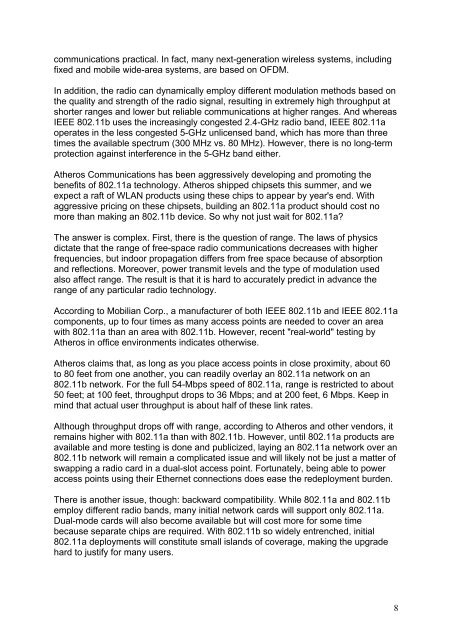Wireless LAN
Wireless LAN
Wireless LAN
You also want an ePaper? Increase the reach of your titles
YUMPU automatically turns print PDFs into web optimized ePapers that Google loves.
communications practical. In fact, many next-generation wireless systems, including<br />
fixed and mobile wide-area systems, are based on OFDM.<br />
In addition, the radio can dynamically employ different modulation methods based on<br />
the quality and strength of the radio signal, resulting in extremely high throughput at<br />
shorter ranges and lower but reliable communications at higher ranges. And whereas<br />
IEEE 802.11b uses the increasingly congested 2.4-GHz radio band, IEEE 802.11a<br />
operates in the less congested 5-GHz unlicensed band, which has more than three<br />
times the available spectrum (300 MHz vs. 80 MHz). However, there is no long-term<br />
protection against interference in the 5-GHz band either.<br />
Atheros Communications has been aggressively developing and promoting the<br />
benefits of 802.11a technology. Atheros shipped chipsets this summer, and we<br />
expect a raft of W<strong>LAN</strong> products using these chips to appear by year's end. With<br />
aggressive pricing on these chipsets, building an 802.11a product should cost no<br />
more than making an 802.11b device. So why not just wait for 802.11a?<br />
The answer is complex. First, there is the question of range. The laws of physics<br />
dictate that the range of free-space radio communications decreases with higher<br />
frequencies, but indoor propagation differs from free space because of absorption<br />
and reflections. Moreover, power transmit levels and the type of modulation used<br />
also affect range. The result is that it is hard to accurately predict in advance the<br />
range of any particular radio technology.<br />
According to Mobilian Corp., a manufacturer of both IEEE 802.11b and IEEE 802.11a<br />
components, up to four times as many access points are needed to cover an area<br />
with 802.11a than an area with 802.11b. However, recent "real-world" testing by<br />
Atheros in office environments indicates otherwise.<br />
Atheros claims that, as long as you place access points in close proximity, about 60<br />
to 80 feet from one another, you can readily overlay an 802.11a network on an<br />
802.11b network. For the full 54-Mbps speed of 802.11a, range is restricted to about<br />
50 feet; at 100 feet, throughput drops to 36 Mbps; and at 200 feet, 6 Mbps. Keep in<br />
mind that actual user throughput is about half of these link rates.<br />
Although throughput drops off with range, according to Atheros and other vendors, it<br />
remains higher with 802.11a than with 802.11b. However, until 802.11a products are<br />
available and more testing is done and publicized, laying an 802.11a network over an<br />
802.11b network will remain a complicated issue and will likely not be just a matter of<br />
swapping a radio card in a dual-slot access point. Fortunately, being able to power<br />
access points using their Ethernet connections does ease the redeployment burden.<br />
There is another issue, though: backward compatibility. While 802.11a and 802.11b<br />
employ different radio bands, many initial network cards will support only 802.11a.<br />
Dual-mode cards will also become available but will cost more for some time<br />
because separate chips are required. With 802.11b so widely entrenched, initial<br />
802.11a deployments will constitute small islands of coverage, making the upgrade<br />
hard to justify for many users.<br />
8
















